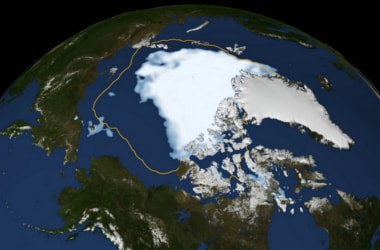Warming ocean & atmosphere in the Arctic affect Sea Ice Cap!
Q. As a vast extent of Arctic Sea, a massive sheath of frozen seawater has shrunk leaving which part more vulnerable to the warming ocean and atmosphere?- Published on 01 Nov 16a. Sea ice cap
b. Sea ice
c. Ocean ice
d. Sea water
ANSWER: Sea ice cap

As the extent of the Arctic Sea Ice, a vast sheath of frozen seawater floating on the Arctic Ocean and the neighbouring seas, shrinks, its oldest and thicker ice has either thinned or melted away, ensuring that the sea ice cap is more vulnerable to the warmed oceans and atmosphere.
- The older ice is disappearing; scientists have likened it to the bulwark of sea ice. A warm summer melts the thin and young ice, but it cannot ensure the end of the older ice.
- The older ice is is weaker as there is less of it and the remaining old ice is broken up and thinner, so the bulwark is not as good as it was previously.
- Direct measurements of sea ice thickness are sporadic and incomplete across the Arctic so scientists have developed sea ice age estimates and tracked their evolution from 1984 to current times.
- A new NASA visualisation of the age of the Arctic Sea Ice shows how sea ice has been undergoing growth and shrinking, spinning, melting in place and drifting out of the Arctic for the past 30 years.
- The old sea ice is melting within the Arctic Ocean during the summertime and this is because the multiyear ice would be considered an ice pack and now small chinks of old ice are interspersed with the new ones.
- Most of the older ice has been lost; in the 1980s, multiyear ice made up 20 percent of the sea ice cover; now it is only about three percent.
- Older ice was the safety net of the Arctic sea ice pack and as it is lost, the likelihood for an ice free summer in the Arctic increases.